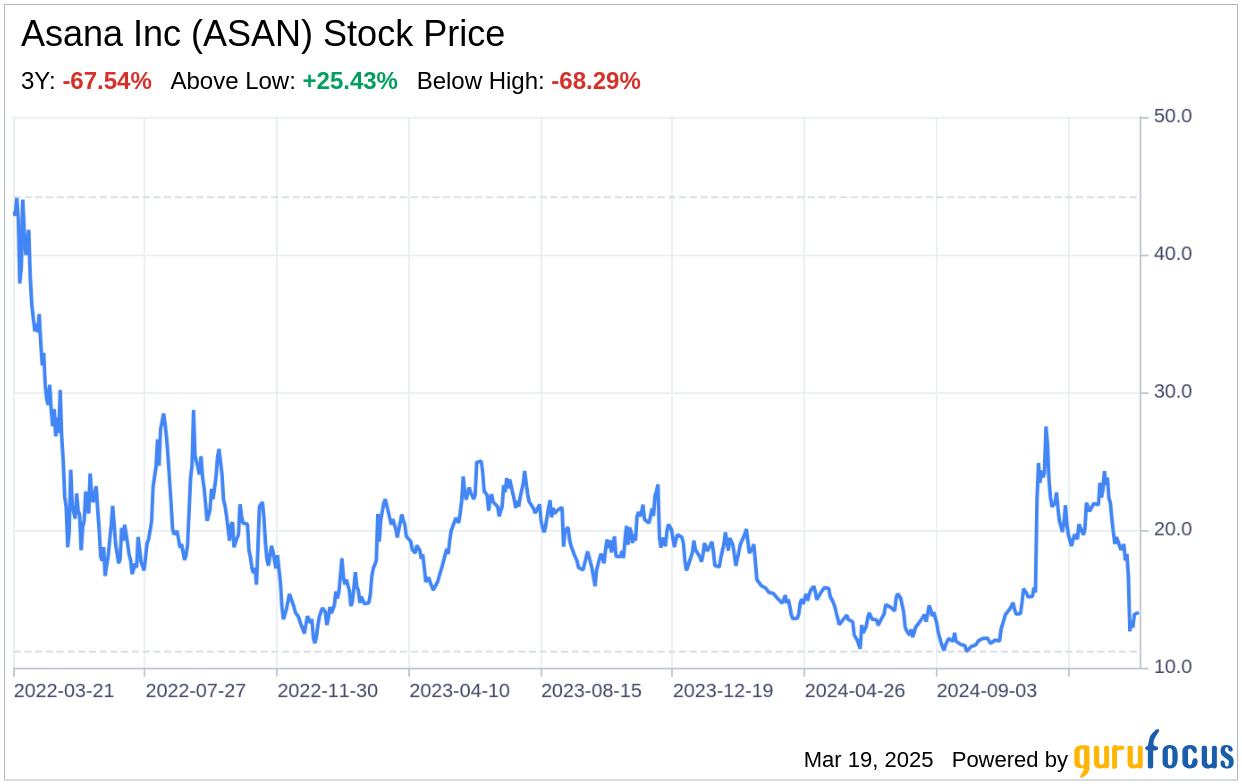Asana Inc (ASAN, Financial), a leading provider of collaborative work management software, filed its 10-K report on March 18, 2025, offering a comprehensive view of its financial health and strategic direction. The company has demonstrated consistent revenue growth, with a reported increase from $547,212 in 2023 to $723,876 in 2025. However, Asana continues to operate at a loss, with a net loss of $(255,536) in the latest fiscal year, albeit a slight improvement from the previous year's $(257,030). The company's investment in research and development and sales and marketing remains substantial, indicating a strategic focus on innovation and market expansion. This financial overview sets the stage for a deeper SWOT analysis, providing investors with insights into Asana's strengths, weaknesses, opportunities, and threats.

Strengths
Brand Power and Customer Base: Asana Inc (ASAN, Financial) has cultivated a strong brand and loyal customer base, with over 169,000 paying customers globally. The company's focus on creating a unified platform for work management has resonated with users, leading to a diverse customer base across various industries. Asana's brand is synonymous with efficiency and clarity in project management, which has been a key factor in its customer acquisition and retention strategies.
Innovative Technology and AI Integration: Asana's commitment to innovation is evident in its significant investment in research and development, totaling $341,467 in the latest fiscal year. The launch of Asana AI Studio showcases the company's dedication to enhancing its platform with AI capabilities, providing users with no-code solutions to design custom AI agents. This technological edge positions Asana at the forefront of the work management software market.
Scalable and Dynamic SaaS Model: The company's cloud-based SaaS model offers scalable solutions that cater to a wide range of use cases, from marketing programs to IT approvals. Asana's tiered subscription model, ranging from Personal to Enterprise+, allows for flexibility and growth alongside its customers' evolving needs. The per-seat subscription revenue model ensures a steady stream of income and potential for expansion within existing customer organizations.
Weaknesses
Financial Performance and Profitability: Despite revenue growth, Asana Inc (ASAN, Financial) has yet to achieve profitability, with a net loss reported in the latest fiscal year. The company's operating expenses, particularly in sales and marketing, have outpaced revenue growth, leading to concerns about its long-term financial sustainability. Asana's challenge lies in balancing investment in growth with the need to improve its bottom line.
Competitive Market Landscape: Asana operates in a highly competitive industry, where it faces ongoing threats from both established players and new entrants. The company's ability to maintain its competitive edge relies on continuous development and deployment of new technologies, such as AI, which requires substantial investment and resources.
Dependence on Third-Party Marketplaces: The distribution of Asana's mobile application is reliant on third-party marketplaces, which poses a risk if these platforms change their policies or interfere with the distribution process. This dependence could potentially limit Asana's reach and affect its user acquisition strategy.
Opportunities
Market Expansion and International Growth: Asana Inc (ASAN, Financial) has the opportunity to further expand its international presence, with paying customers across 200 countries and territories. The company's ability to cater to a global audience with localized solutions and support can drive significant growth and diversify its revenue streams.
Product Development and AI Advancements: The introduction of Asana AI Studio opens up new avenues for product innovation and differentiation. Asana can leverage its AI capabilities to enhance user experience, automate complex workflows, and offer advanced analytics, which can attract new customers and deepen engagement with existing ones.
Strategic Partnerships and Integrations: Asana's robust API and integration with third-party applications like Microsoft Teams, Slack, and Salesforce present opportunities to create a more cohesive ecosystem for users. By strengthening partnerships and developing new integrations, Asana can increase its platform's value proposition and user stickiness.
Threats
Regulatory Compliance and Data Protection: Asana Inc (ASAN, Financial) must navigate an increasingly complex landscape of privacy, data protection, and security regulations. Non-compliance could lead to regulatory actions, fines, and reputational harm, which could adversely affect the company's business operations and financial results.
Market Volatility and Stock Price Fluctuations: The trading price of Asana's Class A common stock is subject to volatility, which could impact investor confidence and the company's ability to raise capital if needed. Rapid and significant declines in stock price could also affect Asana's market capitalization and its appeal to potential investors.
Talent Acquisition and Retention: Asana's success hinges on its ability to attract and retain highly qualified personnel in a competitive market. Failure to maintain a talented workforce could hinder the company's innovation efforts and growth plans, ultimately impacting its competitive position.
In conclusion, Asana Inc (ASAN, Financial) exhibits a strong brand presence, innovative technology, and a scalable SaaS model that position it well for continued growth in the collaborative work management space. However, the company's ongoing financial losses, competitive pressures, and reliance on third-party market
This article, generated by GuruFocus, is designed to provide general insights and is not tailored financial advice. Our commentary is rooted in historical data and analyst projections, utilizing an impartial methodology, and is not intended to serve as specific investment guidance. It does not formulate a recommendation to purchase or divest any stock and does not consider individual investment objectives or financial circumstances. Our objective is to deliver long-term, fundamental data-driven analysis. Be aware that our analysis might not incorporate the most recent, price-sensitive company announcements or qualitative information. GuruFocus holds no position in the stocks mentioned herein.
